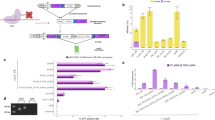Abstract
Zinc-finger nucleases (ZFNs) are versatile reagents that have redefined genome engineering. Realizing the full potential of this technology requires the development of safe and effective methods for delivering ZFNs into cells. We demonstrate the intrinsic cell-penetrating capabilities of the standard ZFN architecture and show that direct delivery of ZFNs as proteins leads to efficient endogenous gene disruption in various mammalian cell types with minimal off-target effects.
This is a preview of subscription content, access via your institution
Access options
Subscribe to this journal
Receive 12 print issues and online access
$259.00 per year
only $21.58 per issue
Buy this article
- Purchase on Springer Link
- Instant access to full article PDF
Prices may be subject to local taxes which are calculated during checkout


Similar content being viewed by others
References
Kim, Y.G. & Chandrasegaran, S. Proc. Natl. Acad. Sci. USA 91, 883–887 (1994).
Santiago, Y. et al. Proc. Natl. Acad. Sci. USA 105, 5809–5814 (2008).
Hockemeyer, D. et al. Nat. Biotechnol. 27, 851–857 (2009).
Doyon, Y. et al. Nat. Biotechnol. 26, 702–708 (2008).
Geurts, A.M. et al. Science 325, 433 (2009).
Perez, E.E. et al. Nat. Biotechnol. 26, 808–816 (2008).
Holt, N. et al. Nat. Biotechnol. 28, 839–847 (2010).
Sander, J.D. et al. Nat. Methods 8, 67–69 (2011).
Doyon, Y. et al. Nat. Methods 7, 459–460 (2010).
Guo, J., Gaj, T. & Barbas, C.F. III. J. Mol. Biol. 400, 96–107 (2010).
Thomas, C.E., Ehrhardt, A. & Kay, M.A. Nat. Rev. Genet. 4, 346–358 (2003).
Warren, L. et al. Cell Stem Cell 7, 618–630 (2010).
Diebold, S.S. et al. Science 303, 1529–1531 (2004).
Van Tendeloo, V.F. et al. Gene Ther. 7, 1431–1437 (2000).
Gabriel, R. et al. Nat. Biotechnol. 29, 816–823 (2011).
Pruett-Miller, S.M., Reading, D.W., Porter, S.N. & Porteus, M.H. PLoS Genet. 5, e1000376 (2009).
Golovanov, A.P., Hautbergue, G.M., Wilson, S.A. & Lian, L.Y. J. Am. Chem. Soc. 126, 8933–8939 (2004).
Guschin, D.Y. et al. Methods Mol. Biol. 649, 247–256 (2010).
Gordley, R.M., Gersbach, C.A. & Barbas, C.F. III. Proc. Natl. Acad. Sci. USA 106, 5053–5058 (2009).
Gaudray, P., Trotter, J. & Wahl, G.M. J. Biol. Chem. 261, 6285–6292 (1986).
Acknowledgements
We thank C. Gersbach for contributing to preliminary studies, P. Ikrenyi for technical assistance and A. Mercer for discussion of the manuscript. This research was supported by US National Institutes of Health (NIH) grants GM065059 and DP1OD006990 and by The Skaggs Institute for Chemical Biology. T.G. was supported by a US National Institute of General Medicine Sciences fellowship (T32GM080209). Y.K. was supported by the Japan Society for the Promotion of Science Research Fellowships for Young Scientists.
Author information
Authors and Affiliations
Contributions
T.G., J.G., Y.K., S.J.S. and C.F.B. designed the research; J.G. and Y.K. purified ZFN proteins; T.G., J.G., Y.K. and S.J.S. performed experiments; T.G., J.G., Y.K., S.J.S. and C.F.B. analyzed data; T.G., S.J.S. and C.F.B. wrote the manuscript.
Corresponding author
Ethics declarations
Competing interests
The authors are inventors on wide-ranging patents concerning the development and use of zinc-finger technology (US Patent Nos. 6,140,081, 6,140,466, 6,242,568, 6,610,512, 6,790,941, 7,011,972, 7,067,617, 7,101,972, 7,151,201, 7,329,541, 7,329,728, 7,378,510, 7, 442,784, 7,741,110, 7,781,645 and 7,833,784) and have also submitted an application to the US Patent Office concerning the contents of this manuscript.
Supplementary information
Supplementary Text and Figures
Supplementary Figures 1–12, Supplementary Tables 1 and 2 and Supplementary Note (PDF 7554 kb)
Rights and permissions
About this article
Cite this article
Gaj, T., Guo, J., Kato, Y. et al. Targeted gene knockout by direct delivery of zinc-finger nuclease proteins. Nat Methods 9, 805–807 (2012). https://doi.org/10.1038/nmeth.2030
Received:
Accepted:
Published:
Issue Date:
DOI: https://doi.org/10.1038/nmeth.2030
This article is cited by
-
Researching the future: scenarios to explore the future of human genome editing
BMC Medical Ethics (2023)
-
AAV-based in vivo gene therapy for neurological disorders
Nature Reviews Drug Discovery (2023)
-
Genome editing via non-viral delivery platforms: current progress in personalized cancer therapy
Molecular Cancer (2022)
-
Designer nucleases to treat malignant cancers driven by viral oncogenes
Virology Journal (2021)
-
Cardiomyocyte Death and Genome-Edited Stem Cell Therapy for Ischemic Heart Disease
Stem Cell Reviews and Reports (2021)



